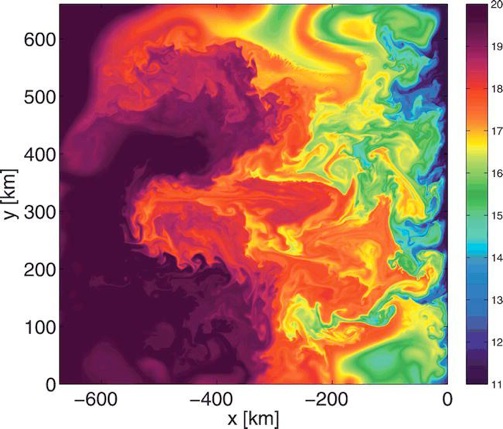California Current System / U.S. West Coast Modeling Projects


Project: Sub-mesoscale Dynamics in Eddying Flow Regimes
In computational simulations of an idealized subtropical eastern boundary upwelling current system, similar to the California Current, a submesoscale transition occurs in the eddy variability as the horizontal grid scale is reduced to O (1) km. The transition in terms of the emergent flow structure and the associated time-averaged eddy fluxes has been examined with ROMS. In addition to the mesoscale eddies that arise from a primary instability in the alongshore, wind-driven currents, significant energy is transferred into submesoscale fronts and vortices in the upper ocean. The submesoscale arises through surface frontogenesis growing off upwelled cold filaments that are pulled offshore and strained in between the mesoscale eddy centers. In turn, some submesoscale fronts become unstable and develop submesoscale meanders and fragment into roll-up vortices. Associated with this phenomenon are a large vertical vorticity and Rossby number; a large vertical velocity; a relatively flat horizontal spectra (contrary to the prevailing view of mesoscale dynamics); a large vertical buoyancy flux acting to restratify the upper ocean; a submesoscale energy conversion from potential to kinetic; a significant spatial and temporal intermittency in the upper ocean; and a material exchanges between the surface boundary layer and pycnocline. Comparison with available observations indicates that submesoscale fronts and instabilities occur widely in the upper ocean, with characteristics similar to the simulations.
The emergent upper-ocean submesoscale fronts are analyzed from phenomenological and dynamical perspectives, using a combination of composite averaging and separation of distinctive subregions of the flow. The initiating dynamical process for the transition is near-surface frontogenesis. The frontal behavior is similar to both observed meteorological surface fronts and solutions of the approximate dynamical model called surface dynamics (i.e., uniform interior potential vorticity q and diagnostic force balance) in the intensification of surface density gradients and in the secondary circulations as a response to a mesoscale strain field. However, there are significant behavioral differences compared to the surface-dynamics model. Wind stress acts on fronts through nonlinear Ekman transport and creation and destruction of potential vorticity. The strain-induced frontogenesis is disrupted by vigorous submesoscale frontal instabilities that in turn lead to secondary frontogenesis events, submesoscale vortices, and excitation of even smaller-scale flows. Intermittent, submesoscale breakdown of geostrophic and gradient-wind force balance occurs during the intense frontogenesis and frontal-instability events.
The mesoscale to submesoscale transition is mainly explained by the emergence of ubiquitous submesoscale density fronts and ageostrophic circulations about them in the weakly stratified surface boundary layer. Here the high-resolution simulations are further analyzed from the perspective of the kinetic energy (KE) spectrum shape and the spectral energy fluxes in the mesoscale-to-submesoscale range in the upper ocean. For wavenumbers greater than the mesoscale energy peak, there is a submesoscale power-law regime in the spectrum with an exponent close to negative 2.
In the KE balance an important conversion from potential to kinetic energy takes place at all wavenumbers in both mesoscale and submesoscale ranges; this conversion is the energetic counterpart of the vertical restratification flux and frontogenesis discussed in the earlier papers.
A significant forward cascade of KE occurs in the submesoscale range en route to dissipation at even smaller scales. This is contrary to the inverse energy cascade of geostrophic turbulence and it is, in fact, fundamentally associated with the horizontally divergent (i.e., ageostrophic) velocity component. The submesoscale dynamical processes of frontogenesis, frontal instability, and breakdown of diagnostic force balance are all essential elements of the energy cycle of potential energy conversion and forward KE cascade.
Instantaneous surface temperature T (x, y) field at time t = 208 days after ICC initialization, as an example of a suite of computational simulations for an idealized subtropical, eastern boundary, upwelling current system [referred to as the idealized California Current (ICC)].
Note the string of meanders and filaments in 17 to 19 degree Centigrade water with wavelengths approximately 50 km running along the edges of the offshore eddies. Notice also that an instability event is located at (x equals approximately negative 250 km, y equals approximately 350 km); it separates waters in the range 16 to 18 degrees Centigrade, and the temperature front is roughly aligned with the x axis.

Related publications